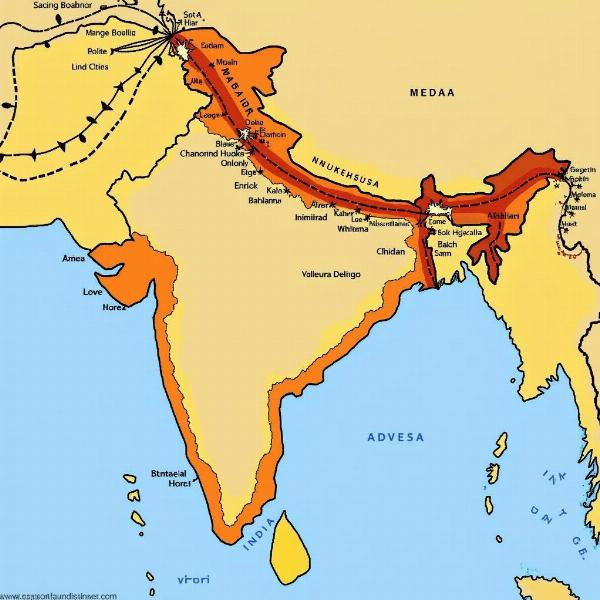The term “Mughal meaning in Hindi” often leads to a search for मुग़ल (pronounced “mughal”), which simply translates to “Mughal.” However, understanding the true significance of the Mughals requires delving deeper than a simple translation. This article explores the multifaceted meaning of “Mughal” within the Hindi language and Indian cultural context, encompassing its historical, political, artistic, and linguistic implications.
The Mughal Dynasty: A Historical Overview
The Mughal Empire, a powerful dynasty of Turkic-Mongol origin, ruled much of the Indian subcontinent for over three centuries, from the early 16th to the mid-19th century. Their reign profoundly impacted India’s history, leaving an indelible mark on its art, architecture, language, and culture. From Babur’s initial victory at Panipat in 1526 to the decline under Bahadur Shah Zafar II in 1857, the Mughal era witnessed a complex interplay of power, cultural exchange, and societal transformation.
 Mughal Empire Map of India
Mughal Empire Map of India
Mughal Influence on Language and Culture
The Mughals, despite their foreign origins, gradually integrated into the Indian fabric, adopting and influencing local customs and languages. Persian, the official language of the Mughal court, significantly impacted Hindi, giving rise to Urdu, a new language that blended Persian vocabulary and grammar with the existing Hindi vernacular. This linguistic fusion reflects the broader cultural synthesis that characterized the Mughal period. The influence is evident in numerous words used daily in Hindi, enriching its vocabulary and adding a layer of sophistication.
Mughal Architecture and Art: A Legacy of Grandeur
The Mughal era is renowned for its magnificent architecture and art. Iconic structures like the Taj Mahal, Red Fort, and Humayun’s Tomb stand as testaments to the Mughals’ architectural prowess and artistic vision. Their patronage of painting, music, and literature further enriched India’s cultural landscape. These artistic expressions are not merely aesthetically pleasing but also offer insights into the social and political dynamics of the time. Do you ever wonder about the stories behind these magnificent creations?
Mughal Administration and Governance: The Mansabdari System
The Mughals implemented a sophisticated administrative system, the mansabdari system, which played a crucial role in maintaining their vast empire. This hierarchical structure, based on ranks (mansabs), defined the responsibilities and privileges of officials, ensuring efficient governance and military organization. mansab meaning in hindi This system, while effective, also had its inherent challenges, contributing to the empire’s eventual decline.
The Decline of the Mughal Empire: Internal Strife and External Pressures
The later Mughal period was marked by internal conflicts, succession disputes, and the rise of regional powers. The increasing influence of the British East India Company further weakened the Mughal hold, eventually leading to the empire’s demise. Understanding this decline offers valuable lessons in statecraft and the complexities of power dynamics.
Conclusion: “Mughal Meaning in Hindi” – Beyond a Simple Translation
The meaning of “Mughal” in Hindi goes beyond a simple translation. It represents a significant historical period, a dynasty that shaped India’s cultural and linguistic landscape, and a legacy that continues to resonate today. From architectural marvels to linguistic influences, the Mughals’ impact on India is undeniable. mughal emperor meaning in hindi Exploring this rich history allows us to appreciate the complex interplay of cultures and the enduring power of the past.
FAQ:
- What does Mughal mean in Hindi? Mughal in Hindi is मुग़ल (mughal), referring to the Mughal dynasty.
- When did the Mughal Empire rule India? The Mughal Empire ruled India from the early 16th to the mid-19th century.
- What is the significance of the Taj Mahal? The Taj Mahal is a mausoleum built by Mughal emperor Shah Jahan for his wife Mumtaz Mahal, considered a masterpiece of Mughal architecture.
- What was the official language of the Mughal court? Persian was the official language of the Mughal court.
- What is the Mansabdari system? The Mansabdari system was a hierarchical administrative and military system implemented by the Mughals.
- Who was the first Mughal emperor? Babur was the first Mughal emperor. mughals meaning in hindi
- What contributed to the decline of the Mughal Empire? Internal strife, succession disputes, the rise of regional powers, and the growing influence of the British East India Company contributed to the decline of the Mughal Empire. predominated meaning in hindi alamgir meaning in hindi
Meaning-Hindi.in is your trusted partner for professional Hindi translation services, catering to diverse needs from business and legal documents to technical manuals and website localization. We offer accurate, culturally sensitive translations across various specialized domains. Contact us today to discuss your translation requirements! Email: [email protected], Phone: +91 11-4502-7584. Meaning-Hindi.in understands the nuances of both Hindi and English, ensuring precise and effective communication for your global audience.